Some Lyrids Meteors Linger and the Evening Moon Poses with Planets Stars, and Clusters!
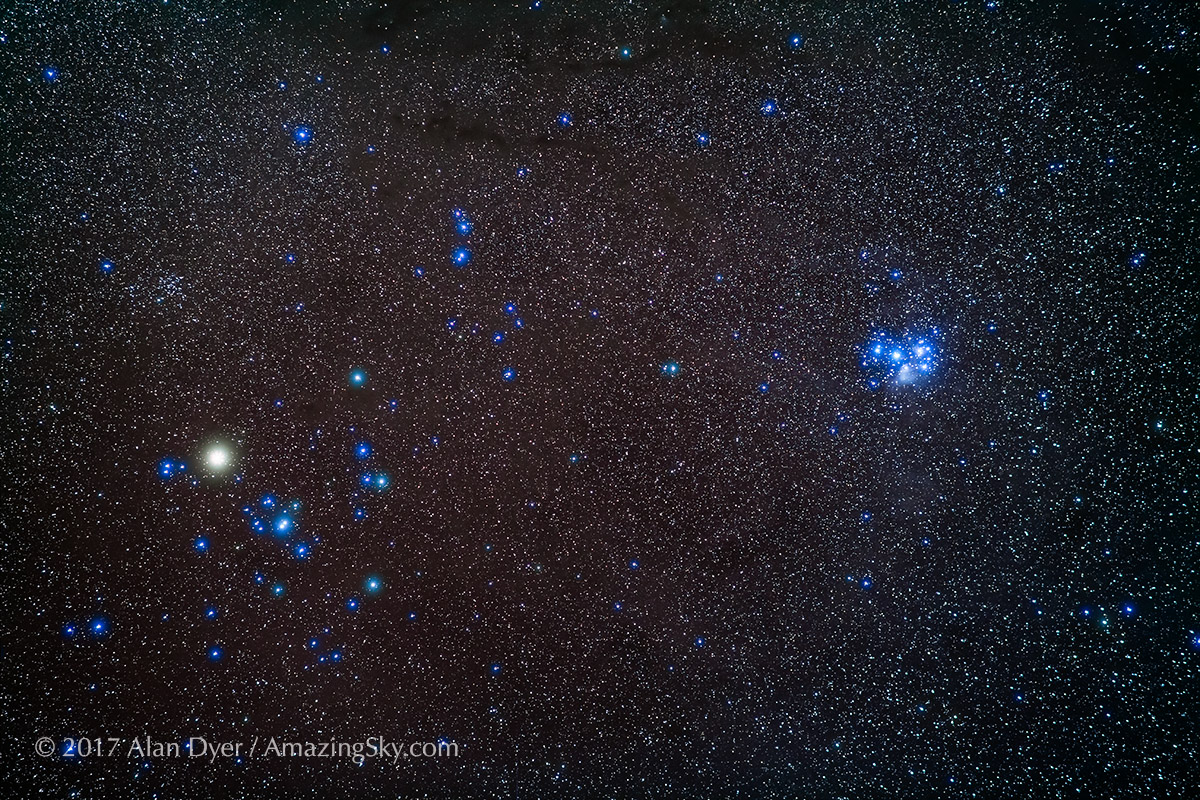
This beautiful natural image of the Hyades and the Pleiades clusters in Taurus, was captured and processed by Alan Dyer while he was travelling to Arizona in December, 2017. He used a Canon 5D MkII camera on a tracking mount and a total of eight minutes of exposure. The bright star Aldebaran at left is the eye of the bull, who’s V-shaped face is composed of the Hyades’ stars. The smaller, but brighter Pleiades cluster shines at upper right. Both clusters are relatively close to our sun. More image details are at Alan’s Flickr page https://www.flickr.com/photos/amazingsky/39067720482. Visit his website https://amazingsky.net/ for more images, astronomy news, and astrophotography information.
Hello, late-April Stargazers!
Here are your Astronomy Skylights for the week of April 23rd, 2023 by Chris Vaughan. Feel free to pass this along to your friends and send me your comments, questions, and suggested topics. You can also follow me on Twitter as @astrogeoguy! Unless otherwise noted, all times are expressed in Eastern Time. To subscribe to these emails please click this MailChimp link.
If you’d like me to bring my Digital Starlab portable inflatable planetarium to your school or other daytime or evening event, or deliver a session online, contact me through AstroGeo.ca, and we’ll tour the Universe, or the Earth’s interior, together! My terrific book with John A. Read entitled 110 Things to See With a Telescope is a guide to viewing the deep sky objects in the Messier List – for both beginners and seasoned astronomers. DM me to order a signed copy!
The waxing moon will conveniently shine in evening worldwide all week long, so pull out your binoculars and telescopes and take a look at its spectacular surface! The moon will also pose next to some bright planets, as well as some interesting stars and star clusters. The Lyrids meteor shower will taper off early in the week, so keep looking up. The minor planet Ceres will be approaching the lion’s tail star and Saturn will be visible before sunrise. Read on for your Skylights!
Lyrids Meteor Shower
The annual Lyrids Meteor Shower peaked in intensity at approximately 9 pm EDT last night (Saturday, April 22) – but you can expect to see some leftover Lyrids each night as the shower tapers off through Tuesday. I wrote more details about meteor showers and how to best see them here. Keep looking up!
The Moon Poses with Stars and Planets
The waxing moon will shine in the evening sky all around the world this week. While the moon’s orbital motion carries it east and away from the sun, the Earth-facing hemisphere of the moon will fill with light. The lunar terrain alongside the pole-to-pole terminator line, which marks the boundary between the lit and darkened hemispheres, will be bathed with nearly horizontal rays of sunlight that produce breathtaking views in binoculars and backyard telescopes. The moon rises during the daytime at this part of the lunar month, so you can spot the moon in the daytime and be ready for the close-up views when the sky darkens after dinner!

While it waxes, the eastern part of the moon is lit up. For someone standing on the moon anywhere along the terminator, the sun would be just cresting the craggy horizon. From Earth, we see shadows cast to the west of every raised surface – whether it be a rock, boulder, hill, ridge, crater rim, or mountain peak. The floors of deep craters can remain dark while their rims gleam. With no atmosphere to scatter light, the shadows are inky black. As the sun rises higher, the terminator creeps west, hour-by-hour and day after day. We can watch those dark crater floors fill with light – the shape of the shadow crossing them telling us whether the crater is bowl-shaped, or funnel-shaped, or a pie pan. When they are freshly formed, most craters feature a central mountain peak. But aeons of geological processes can partially or completely fill a crater, all or partly hiding its peak. When you are viewing the moon, watch for lit central peaks surrounded by darkness. Check back later to see the change in illumination, and compare craters near the terminator with some much farther from it – it’s fun!
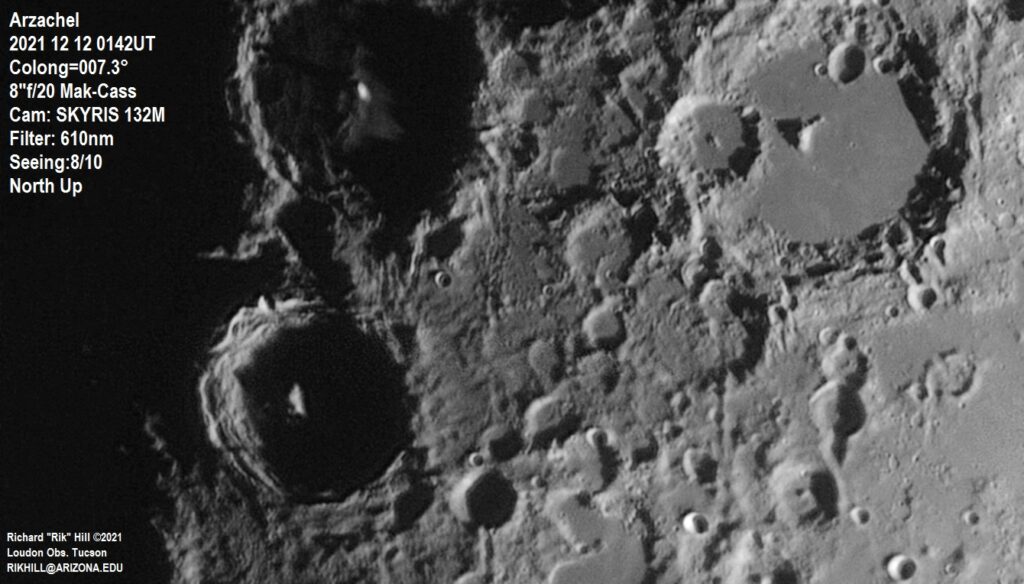
Tonight (Sunday) the moon will shine in the western sky after dusk as a 16%-illuminated crescent a short distance above the brilliant planet Venus – making a terrific photo opportunity. As the stars come out, look for the very bright, reddish star Antares twinkling to the lower left of the moon and Venus. It’s the brightest star in Taurus (the Bull). Elnath, the bull’s second brightest star, marks his right (northern) horn tip. That star will be shining a few finger widths above the moon and a palm’s width above Venus.
By dusk, you’ll notice two groupings of stars below Venus. The scattered stars of the Hyades Cluster, also known as Melotte 25, form the bull’s triangular face immediately to the right of Aldebaran. The Pleiades Star Cluster, also known as Messier 45, Matariki, the Seven Sisters, and the Hole in the Sky, among many other names, will be sitting about a fist’s width to the right of Aldebaran. Both clusters, the closest deep sky objects to us, look terrific in binoculars. Venus, the stars of Taurus, and those clusters will be there every night, but the moon will hop away from them.
In early evening on Sunday and Monday, see if catch Earthshine on the moon. Sometimes called the Ashen Glow or the Old Moon in the New Moon’s Arms, the phenomenon is visible within a day or two of new moon, when sunlight reflected off Earth and back toward the moon slightly brightens the unlit portion of the moon’s Earth-facing hemisphere. Monday’s slightly fuller crescent will shine in Gemini (the Twins), about midway between Venus and the much fainter, reddish dot of Mars.
On Tuesday night, the moon will sit several finger widths to the right (or 3° to the celestial north) of Mars. The duo will be cozy enough to share the field of view in binoculars. Both solar system objects will be surrounded by four of the brightest stars in Gemini: Castor and Pollux marking the twin’s heads, and Wasat and Mebsuta marking their waists. The medium-bright star Iota Geminorum, which is located below and between Pollux and Castor, is a pretty sight in binoculars. In some depictions of Gemini, the grouping of stars that includes Iota Geminorum represents the twins’ clasped hands.

The moon will continue to play with the twins on Wednesday night, when it will form a bent line with Pollux and Castor. The moon will shine binoculars-close to Pollux, on that star’s left (or southern) side. Castor, which is a spectacular double star in your backyard telescope, will twinkle to their right. As the night wears on, the moon’s eastward orbital motion will increase the length of their line – especially by the time all three set around 3 am local time.
The moon will complete the first quarter of its orbit around Earth on Thursday at 5:20 pm EDT or 2:20 pm PDT and 21:20 Greenwich Mean Time. At first quarter, the relative positions of the Earth, sun, and moon cause us to see our natural satellite half-illuminated – on its eastern side. That’s the only time we see the terminator as a straight line, which told the ancients that the moon was a sphere!
Thursday night’s half-moon will shine in Cancer (the Crab), and positioned a few finger widths above another star cluster, the Beehive Cluster or Messier 44. To see the “bees” most easily, hide the moon just beyond the top of your binoculars’ field of view and look for a faint, but dense scattering of stars that cover more than twice the area of the moon! A pair of stars that shines at the limit of unaided eyes visibility flank the Beehive. They are Asellus Borealis “the Northern Small Donkey” on the upper right and Asellus Australis “the Southern Small Donkey” on the lower left – names leftover from a previous interpretation of Cancer’s stars. Interestingly, the name Asellus is now used as a genus of isopod crustaceans, due to their presence in Cancer.
The waxing gibbous moon (i.e., more than half-full) will spend the coming weekend partying with Leo (the Lion). On Friday it will shine to the right (celestial west) of the Sickle-shaped stars of Leo’s head and chest. On Saturday, it will form a triangle to the left of the bright stars Regulus and Algieba. And on Sunday it will hop to sit below the lion’s hindquarters.

On Friday night, the moon’s slightly gibbous phase will favor a look at a trio of large craters located a short distance south of the moon’s center. Ptolemaeus, Alphonsus, and Arzachel are all large enough to see with binoculars and any size of telescope. The northernmost crater Ptolemaeus (154 km wide) has been battered by later impacts that confirm its older age. The flat, almost featureless floor has been filled by lava flows, submerging its central peak and elevating its floor. Alphonsus (119 km wide) is older yet and partially filled, allowing its central peak to remain visible. Alphonsus contains a triangle of dark spots that are most prominent when the moon is full – ash deposits from long-ago volcanic venting. Relatively young Arzachel (96 km wide) has an unaltered floor and a terraced rim. A large number of north-south scratches, or lineations, surround those craters – carved by ejecta during the powerful Imbrium Basin impact event.
Also on Friday the terminator will fall just to the left (or lunar west) of Rupes Recta, also known as the Lunar Straight Wall. The rupes, Latin for “cliff”, is a north-south aligned fault scarp that extends for 110 km across the southeastern part of Mare Nubium, the Sea of Clouds. That’s the dark patch sitting in the lower third of the moon’s Earth-facing hemisphere. The wall, which is very easy to see in good binoculars and backyard telescopes, is located above the very bright, central-peaked crater Tycho.
The Planets
Although Mercury and Uranus will be lurking within the twilight above the west-northwestern horizon for a short time after sunset, the planets Venus and Mars will draw our attention this week.
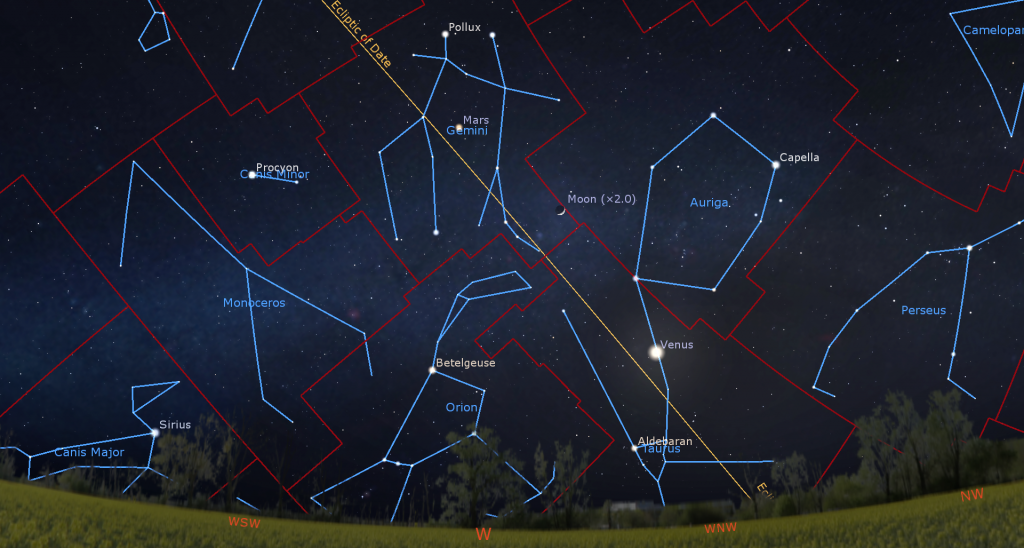
As I mentioned above, Venus will start this week posing with the pretty crescent moon – take a photo! The extremely bright planet will appear about one-third of the way up the sky at sunset and then sink until it sets towards midnight local time. Viewed in a telescope this week, Venus will display a gibbous 70%-illuminated disk that is waning daily. To see Venus’ shape most clearly in a telescope, view the planet as soon as you can locate it through your optics, when it will be higher and shining through less intervening air.
The sky will need to be getting dark before the weak, magnitude 1.3 dot of Mars appears in central Gemini (the Twins), about two-thirds of the way up the west-southwestern sky. The planet continues to fade in brightness and become smaller in telescopes as Earth increases its distance from the red planet. Mars will look best in a telescope while it’s perched on high – but it will look tiny under any magnification. The planet will set during the wee hours of the night.
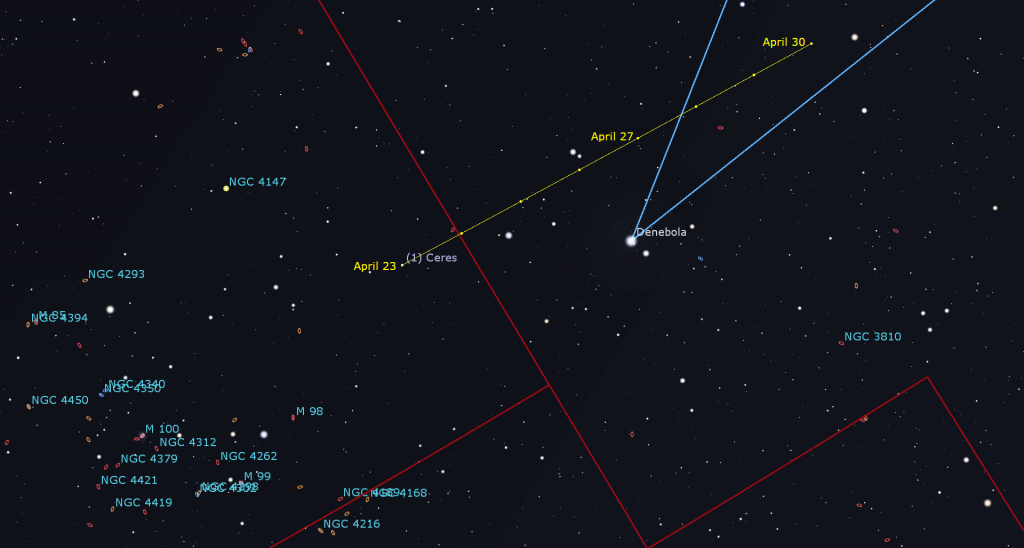
After visiting several members of the Virgo Cluster of Galaxies during March, Ceres, the largest object in the Main Asteroid Belt between Mars and Jupiter, is leaving galaxy-territory behind and approaching the tail of the lion. Tonight (Sunday), the magnitude 7.4 minor planet will be located several finger widths to the left (or 3.5 ° to the celestial ENE) of the bright star Denebola. Ceres will slide a finger’s width to the right each night. Next Sunday night, it will be 2.9° to the upper left of Denebola.
If you are outside around 5:30 am local time and you have a clear view of the east-southeastern horizon, watch for the yellowish dot of Saturn shining among the faint stars of Aquarius (the water-Bearer). The ringed planet will rise 4 minutes earlier each day. It’ll start rising before midnight around the end of June.
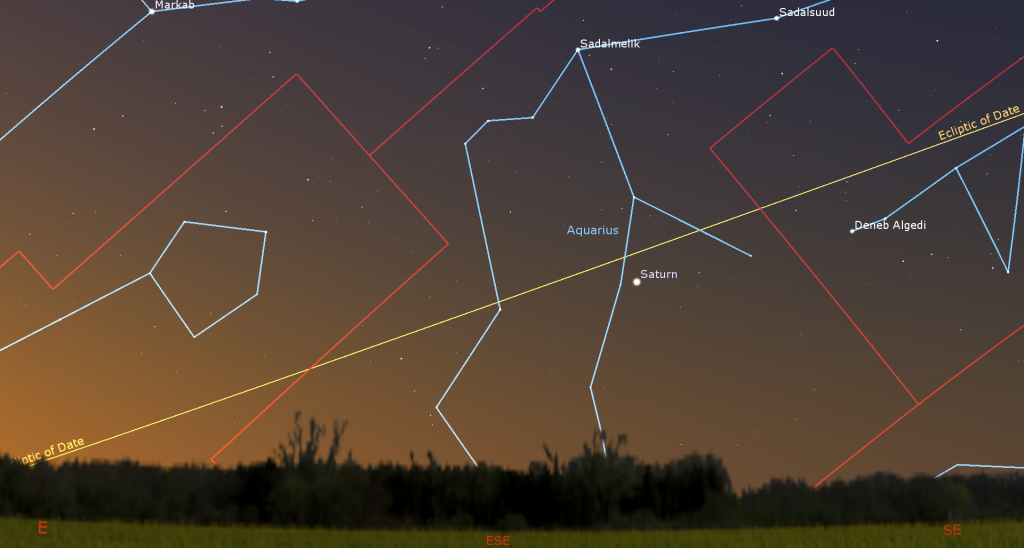
Public Astro-Themed Events
Every Monday evening, York University’s Allan I. Carswell Observatory runs an online star party – broadcasting views from four telescopes/cameras (weather permitting), answering viewer questions, and taking requests! Details are here. They host in-person viewing on the first clear Wednesday night each month. On Wednesdays they stream views online via the observatory YouTube channel. Details are here.
Taking advantage of the crescent moon in the sky this week, the RASC Toronto Centre astronomers will hold their monthly City Sky Star Party in Bayview Village Park (steps from the Bayview subway station), starting after dusk on the first clear weeknight this week (Mon to Thu only). Check here for details, and check the banner on their website home page or Facebook page for the GO or NO-GO decision around 5 pm each day.
My free, family-friendly Insider’s Guide to the Galaxy webcast with RASC National returns on Tuesday, April 25 at 3:30 pm EST. We’ll de-mystify the magnitude and brightness scale that astronomers use to measure and report how bright things are and how bright they look. Then we’ll wrap up by highlighting our next batch of spring RASC Finest NGC objects. You can find more details and the schedule of future sessions here.
Eastern GTA sky watchers are invited to join the RASC Toronto Centre and Durham Skies for solar observing and stargazing at the edge of Lake Ontario in Millennium Square in Pickering on Friday evening, April 28, from 6 pm to 11 pm. Details are here. Before heading out, check the RASCTC home page for a Go/No-Go call – in case it’s too cloudy to observe.
On Saturday, April 29 from 9 to 11 pm EDT, the in-person DDO Astronomy Speakers Night program will feature Dr. Keir Rogers, a Dunlap Fellow at the University of Toronto. He will speak on A Search for Dark Matter in the Cosmic Web. After the presentation, participants will tour the observatory and see a demonstration of the 74” telescope pointed to an interesting celestial object for the visitors to view (weather permitting). More information is here and the registration link is here.
This spring, spend a Sunday afternoon in the other dome at the David Dunlap Observatory! On Sunday afternoon, April 30, you can join me in my Starlab Digital Planetarium for an interactive journey through the Universe at DDO. We’ll tour the night sky and see close-up views of galaxies, nebulas, and star clusters, view our Solar System’s planets and alien exo-planets, land on the moon, Mars – or the Sun, travel home to Earth from the edge of the Universe, hear indigenous starlore, and watch immersive fulldome movies! Ask me your burning questions, and see the answers in a planetarium setting – or sit back and soak it all in. We run sessions at 1 pm and 2:30 pm. More information and the registration links are here.
Keep looking up, and enjoy the sky when you do. I love questions and requests. Send me some!